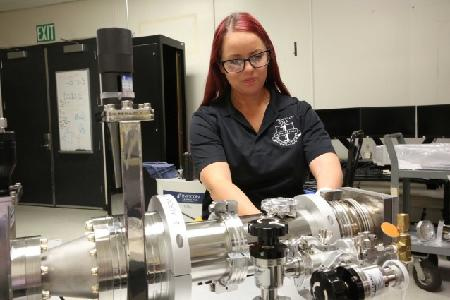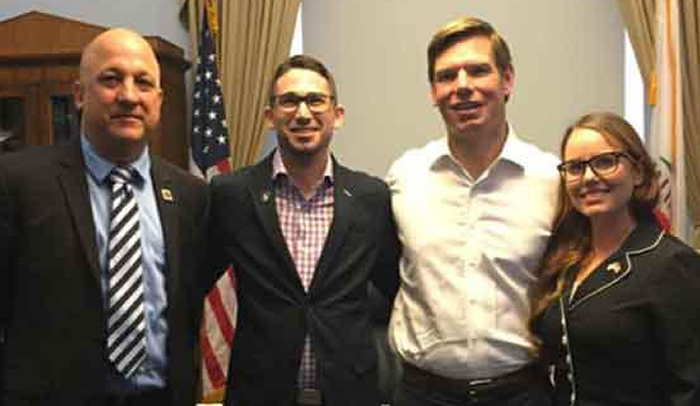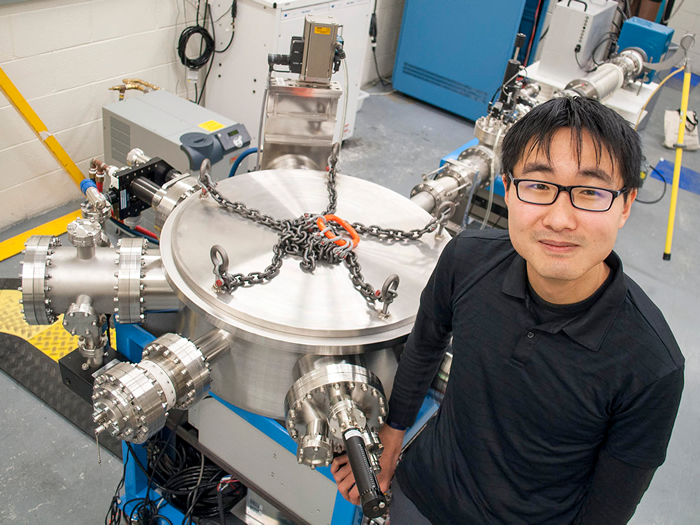NIF & PS People - 2017
March
Hong Sio: On the Road for Fusion
NIF Engineer Wins Scholarship for Women Veterans
U.S. Marine Corps veteran Destiny Goddu has spent her whole life working with machines. As a young girl growing up in Livermore, California, she helped her father, a mechanic, disassemble and rebuild car engines and tinkered with auto parts in the family garage. After joining the Marines, she worked on missile guidance systems; and as an LLNL employee, hired part-time through the award-winning Veterans to Technology program, she builds x-ray sources that verify diagnostic operations prior to being fielded on NIF.
Last month the nonprofit Valley Veterans Foundation recognized Goddu’s dedication and perseverance with a $10,000 scholarship for women veterans in science, technology, engineering and math (STEM). Goddu said the money will help her finish her degree at nearby Las Positas College and further her education in engineering.

“I’ve worked very hard,” Goddu said. “Between math and physics, it’s pretty intense, especially when you’re working. There aren’t a lot of women in STEM careers and women veterans in STEM are even more rare. To have this (scholarship) go toward that is huge. I’m very fortunate and really thankful to everyone involved.”
In the Marines, Goddu was an aviation electrician and worked on forward-looking infrared guidance systems deployed on cargo ships and used on the F-18 jet fighter. When she arrived at the Laboratory to begin her 10-week internship last summer, she was immediately tossed into building a Multi-Anode Manson Source (MAMS), a DC x-ray source that verifies diagnostic response, ensuring these instruments are ready and capable of acquiring data during NIF experiments. She built the entire machine from the ground up, using an older system as a basic template and bringing its vacuum control systems into the 21st Century.
“I came in here not knowing what any of this was,” Goddu said. “The Marine Corps had manuals and detailed procedures; there is no manual for this configuration. I really enjoyed the hands-on work.
“Saving money is my approach,” she said, “so I pulled a bunch of stuff off the shelf and designed some of the parts (using computer-aided design). They really gave me a lot of freedom with it. To have something you build, thinking what is the most efficient way to do it, and see it in use is so cool.”
Goddu so impressed her supervisors with her drive, proficiency and ability to catch on to new tasks that they kept her on as an indeterminate employee, working one day a week at NIF while she continues her education.
“She’s really strong, and technically very capable,” said LLNL Engineering Division Superintendent Ron Darbee. “She has all the intangibles from the Marine Corps, where she’s faced bigger challenges than we could ever provide—we find that very appealing. Her combination of mechanical and electronics knowledge was perfect for what we needed.”
As if work and school weren’t enough, Goddu has become an activist for student veterans, lobbying legislators with the group Operation Veterans Research Funding. She is past president of the Student Veterans Organization at Las Positas College and worked at the school’s Veterans Resource Center, which helps connect returned veterans with their benefits. She has visited Washington, D.C., to speak with members of Congress and talked to elected officials in Sacramento about funding similar centers at higher learning institutions across California.
 Goddu met with U.S. Congressman Eric Swalwell (second from right) at his Washington office in 2016 to discuss veteran resource funding. Also pictured are Todd Steffan (far left), Veterans First program coordinator at Las Positas College, and Trevor Kincy, a Las Positas student veteran and officer in the school’s Student Veterans Organization.
Goddu met with U.S. Congressman Eric Swalwell (second from right) at his Washington office in 2016 to discuss veteran resource funding. Also pictured are Todd Steffan (far left), Veterans First program coordinator at Las Positas College, and Trevor Kincy, a Las Positas student veteran and officer in the school’s Student Veterans Organization. “We want resource centers at every community college,” Goddu said. “We want a one-stop shop so vets don’t have to worry about any extra stress. I think veterans could benefit from all over the United States.”
While Goddu ponders her next move, she’ll continue working at Las Positas on her transfer requirements and is scheduled to graduate in May with an associate degree in engineering technology. She plans to apply to UC Davis and UC Berkeley, with a goal of getting her master’s degree in electrical engineering.
Hong Sio: On the Road for Fusion
Massachusetts Institute of Technology (MIT) graduate student Hong Sio has gotten used to being somewhere else. His research as part of the High-Energy-Density Physics (HEDP) team at MIT’s Plasma Science and Fusion Center (PSFC) has rotated him from his Albany Street home facilities in Cambridge, Massachusetts, to California for projects on NIF and to New York for work on the OMEGA laser at the University of Rochester.
“I spent 120 days in hotel rooms last year,” he laughs. “Four months on the road.” All this travel has been necessary to support the kind of research that recently earned his fusion diagnostic a spot on the cover of an American Institute of Physics journal.
 Hong Sio in the PSFC High-Energy-Density Physics accelerator facility, which develops and characterizes nuclear diagnostics for inertial confinement fusion facilities across the country, including NIF. Credit: Paul Rivenberg, PSFC
Hong Sio in the PSFC High-Energy-Density Physics accelerator facility, which develops and characterizes nuclear diagnostics for inertial confinement fusion facilities across the country, including NIF. Credit: Paul Rivenberg, PSFC Sio, a participant in the NIF-MIT PhD Thesis Program, has been taking significant journeys since the age of 10, when his family emigrated from Macau to the United States, settling in southern California. Sio credits a high school summer program at UC Irvine with cementing his interest in science and specifically fusion, a potential source of abundant energy that has been an elusive goal of scientists for decades.
“UCI has an underground, research-grade nuclear reactor for producing medical isotopes—not meant to produce power, but still a really nice reactor,” he says. “Touring that facility made an impression on me. It made me think about how we generate electricity. It made me think about how we are going to generate electricity 30, 50 years from now.”
Sio continued his interest in energy research as a physics major at Harvey Mudd College in Claremont, California. He worked at the department’s high-intensity laser lab, which deepened his interest in lasers, fusion, and graduate study in physics. When he interviewed at MIT with HEDP division head Richard Petrasso, Sio had found a situation, and a research group, that “checked off all the boxes.”
“I thought, ‘Well, this group shoots lasers at things; this group works on fusion. What’s there to think about?’” And his decision was made.
The decision immersed him in inertial confinement fusion (ICF) research and has led to his particle x-ray temporal diagnostic (PTXD) being featured on the cover of the AIP Review of Scientific Instruments. Sio describes the ICF process:
“At the simplest level, we fill a tiny capsule with fusion fuel and fire many lasers at it simultaneously, compressing and heating the fuel. The hotter and more dense the fuel becomes, the more fusion reactions are generated.”
Researchers measure the nuclear products from these fusion reactions with special diagnostics in order to understand what’s happening in the capsule and improve performance. Sio is responsible for the magnetic particle time-of-flight (magPTOF) diagnostic on NIF (see “Measuring NIF Implosions with a Bang”). A project worked on by Hans Rinderknecht—a graduate of the NIF-MIT PhD program—when he was part of the MIT HEDP team, the diagnostic simultaneously measures shock and compression bang times—the moments of peak thermonuclear burn during ICF implosions. Being able to directly measure the shock and compression bang times helps researchers understand the physics involved in ICF implosions and provides necessary feedback for the next experiments.
“NIF is the most energetic laser facility in the world,” Sio says. “OMEGA is the second largest laser facility in the U.S. The opportunity to be so deeply involved at these world-class facilities as a graduate student is nothing short of remarkable.”
A recipient of the Department of Energy National Nuclear Security Administration (NNSA) Stewardship Science Graduate Fellowship, Sio will present his most recent research at NNSA headquarters in Washington, D.C., on May 9.
Sio anticipates graduating from MIT in the fall of 2017 and hopes to continue contributing to ICF fusion research, possibly as a postdoc at MIT, or at other national ICF facilities such as NIF or OMEGA, where his time on the road already has made him a familiar and welcome addition.
—Paul Rivenberg, PSFC



